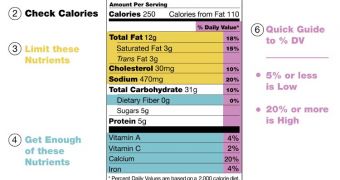According to the conclusions of a new investigation conducted by researchers at the University of Minnesota Division of Epidemiology and Community Health, it would appear that even the most health-conscious consumers don't pay as much attention to nutrition labels as they think they do.
These labels appear on food containers after long legal battles between corporations and health authorities, and contain vital information for people who are trying to remain healthy, who are trying to lose weight, or those who are allergic to certain chemicals or foods.
In a new set of experiments the team conducted, participants were shown a series of products, and then asked to look at them as if they were getting ready to buy them. Researchers then asked test subjects to fill out a series of questionnaires, aimed at gaging precisely how close the people looked at the labels.
About 33 percent of all participants reported that they almost always look at the nutritional labels, counting calories, dangerous fats and so on. However, the science team noticed that only 9 percent of these individuals did so in reality.
The other 24 percent simply thought they had checked out all they wanted to know, study researchers Dan J. Graham and Robert W. Jeffrey say, as quoted by LiveScience. These are very worrying findings, which hint that people don't take advantage even of the simplest things in order to remain healthy.
It was additionally revealed that 31 percent responded positive when asked if they always analyzed trans far, sugar and total fat levels in a single serving of whatever product they were trying to buy.
Yet, eye-tracking devices indicated to experts that only 1 percent of all participants did so in actuality. Regardless of what parameter the team checked, the results remained consistent. People tended to over-report reading nutritional labels by a wide margin.
“The results of this study suggest that consumers have a finite attention span for nutrition facts labels: although most consumers did view labels, very few consumers viewed every component on any label,” Graham and Jeffrey explain.
It was also found that people tended to pay more attention to nutritional labels if they were placed near the top of whatever package they were holding, as opposed to the right or left. This could represent an important avenue of addressing public healthcare issues for authorities.
“Consumers are more likely to view centrally located labels and nutrients nearer the label's top,” the research team concludes.

 14 DAY TRIAL //
14 DAY TRIAL //